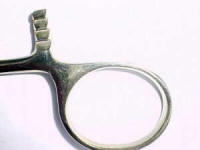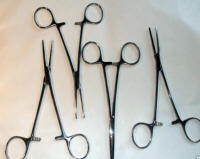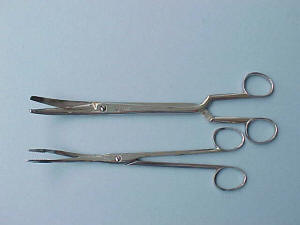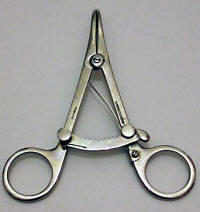Civil War Era Surgical Forceps: Design and Dating Methods
If one looks at the progression of instrument design through the 1700's down to 1900, the major changes are in how the two halves of a forceps or scissor are joined as well as the position and shapes of the finger and thumb holes. Prior to 1870 instruments were typically joined with a screw, which precluded cleaning and sterilization we would expect today. At that time they didn't sterilize, so a screw attachment made the most sense. Since my focus is on the pre-1865 Civil War era until about 1820, I'll show examples of the forceps one would expect in the type of surgical sets shown on this site. At the bottom of the page are several examples of what is not to be expected during this era.
The point in all this minutiae is to point out a method that may help to date a given set of instruments to a given era and thus eliminate other examples by comparison. It's something done while examining a set to determine if an instrument is out of place, replaced, or in fact...correct. It's also how one determines if an isolated instrument would be correct for a given era. As an example, if you are looking at a forceps on eBay, this is how you know it is or isn't right for your set. If a forceps has an disarticulating joint for sterilization and a multi-step ratchet type lock, it's post 1880. (There were single step rachet bullet forceps available from France during the Civil War, but not the three or more step type we see after 1880. If it is chrome plated, it is post 1900. If the metal is unplated, it's early and most likely pre-1870, but if nickel plated, it is later, most likely post 1870. The position of the finger and thumb holes vary greatly from one era and maker to the next. European designs are much different than designs used by American makers, but much copying of design and imports cloud the issue in every era. European instruments were imported by American makers and placed in sets under the maker label name.
There are various instruments referred to as 'forceps': tissue, lithotomy, bullet, sequestrum, bone, artery, etc. The word seems to indicate opposing arms of an instrument, which is joined by a screw or other mechanism to allow movement and approximation of the ends by means of moving the handles.
As you look through the examples, note there is a screw holding the two halves together, there is no locking or ratchet device between the handles, which tells you they are all pre-1890.
See similar articles on dating tourniquets, saws, bone forceps, forceps, or amputation knives.
Click on all images to enlarge
Typical 1800's forceps joint and screw mechanism
None of the instruments on this page are chrome plated or made of stainless steel
An example of a c. 1840 H. Schively lithotomy set of bladder or lithotomy forceps with screw joints, with open finger space and closed thumb hole. This is after a typical English design seen in the early part of the 1800's. In this group is shown a c. 1846, (second from the bottom) forceps by Goulding for bullet or bone fragment removal, the joint is screw type, and the finger holes are off center, but round. Earlier types tend to have ovoid finger holes. This forceps design is pretty common down through the 1860's. By comparison, the tissue forceps at the top of the photo are highly unique with a curved tip. These examples are from an 1850 Martin set. The scissors (basically another type of 'double knife forceps') above, display a cross handle design which allows for power cutting on closure. The tissue forceps below are screw jointed and typical of the 1850's from many American makers. A set of c. 1850 instruments from an ivory Tiemann set. Again, compared to the Marten instruments immediately above, the designs are somewhat different, but still have a screw joint, but the arms of the large lithotomy forceps (second from the top) are more flowing than the angular arms of the Martin scissor. The tissue forceps at the bottom are typical. The bone cutting forceps at the top are typical of the from found during the Civil War and later. This tissue forceps (top) is from a Civil War major bone resection surgery set, c. 1861 by Kolbe. The length is very short, more like what would be expected in a pocket surgical set, but was correct to the set. Note the comparative size of the small locking tissue forceps (tweezers type) An earlier style Hernstein bullet forceps (top) from a c. 1860 set. The open arm is not typical of the 1860's, and may be due to European influence or importation by Hernstein. The bone cutting forceps are much different than the other types seen as they have a round opposing set of cutting edges(bottom left.) A bullet forceps from a Civil War surgery set by Tiemann, c.1865 Note the tip of the forceps are curved and pointed for gaining purchase of the bullet. There is a screw type joint and the finger holes are rotated away from the center line of the instrument. The position of the joint is about two inches from the tip of the instrument to allow for opening deep in a cavity.
A Civil War era bullet forceps by Wade and Ford, screw joint. Photo below is from Frank Hamilton's text book ,Treatise on Military Surgery, 1861:
Another example of a lithotomy forceps (top) with the cross handle design. This from an 1880 Sharp and Smith set. Still with the screw joint. The bone forceps (bottom) are typical of later types with the spring between the handles. Most of the early springs are blued, not plated as are later, post 1890 bone forceps. Another bullet forceps (top), typical post 1860's design, the handles on the scissors scissors are off-set on the upper handle (reversed) to allow keeping the hand away from the cutting surface. Below, is a set of artery forceps with crossed arms to maintain pressure on the jaws of the instrument. Tissue forceps (top) with a grabbing type tip and (bottom) with typical serrated jaws and both with screw joints. These are from an 1886 Helmond set. Well into the era of sterilization and the joint is still non-sterilization design. Note the finger holes are ovoid, not round. Below are examples of post-1895 forceps with multi-step ratchet locking devices and disarticulating or open joints for sterilization. They are not and never have been pre-1895. Pay attention to the details when evaluating pre-1900 instruments. If you see multiple ratchet locks and dis-articulating joints, it is later, and not Civil War era! Also look at the maker names. German makers took over the instrument trade in the 1880's and most of the names from that period and later will be 'German' or have European connections. You need to read extensively to figure this out. Just remember, if it's simple, most likely it's earlier.

Later three or four step ratchet

Later multi-step ratchetContinued....Bone forceps designs 1829 to 1886 and the Civil War






